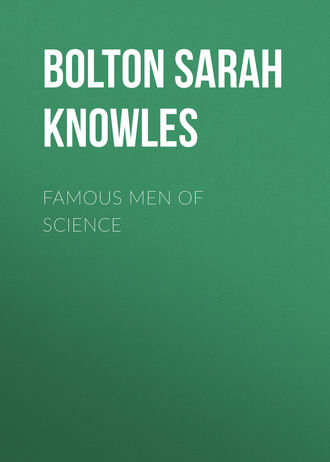 полная версия
полная версияFamous Men of Science
Under the streets of Glasgow, Scotland, seventeen canoes have been dug up, one in a vertical position, as if it had sunk in a storm, with the prow uppermost. Twelve canoes one hundred yards back from the river were found nineteen feet beneath the surface. Almost all were single oak trees, hollowed out by blunt tools, probably stone axes, aided by fire, relics of the stone age.
In caverns near Liège, France, human bones have been found, with the cave-bear, elephant, rhinoceros, and other species now extinct. Skulls found in these primeval caves, especially one near Düsseldorf, called the "Neanderthal," "is the most brutal of all known human skulls, resembling those of the apes." These rude men probably were living at the same time, or even later, than the makers of the "refuse heaps" of Denmark.
Wales has been under the sea to the depth of fourteen hundred feet, as proved by glacial shells; its submergence and reëlevation would require, by careful computation, about two hundred and twenty-four thousand years.
Lyell showed that the Alps, Andes, and Himalaya Mountains were all elaborated under water. "The Alps have acquired four thousand, and even, in some places, more than ten thousand feet of their present altitude since the commencement of the Eocene (dawn of recent) period… It is not too much to say that every spot which is now dry land has been sea at some former period, and every part of the space now covered by the deepest ocean has been land. The present distribution of land and water encourages us to believe that almost every conceivable transformation in the external form of the earth's crust may have been gone through. In one epoch the land may have been chiefly equatorial; in another, for the most part polar and circumpolar."
Lyell showed also the great age of the world by the changes which have taken place in climate. In Greenland are a multitude of fossil plants, which show that it formerly enjoyed a mild and genial climate. Fossil tulip and walnut trees have been found within the Arctic circle.
"On the North American continent, between the Arctic circle and the forty-second parallel of latitude," said Lyell, "we meet with signs of ice-action on a scale as grand, if not grander than in Europe." The drift covered from the Atlantic border of New England and Labrador westward to Dakota and Lake Winnipeg, and farther north, across the continent. Some stones in this bed of ice were thirty feet square, weighing over four million pounds. Some boulders from the Alps, weighing three thousand tons each, are now found on the Juras. "It must, I think," said Lyell, "be conceded that the period required for the coming-on of the greatest cold, and for its duration when most intense, and the oscillations to which it was subject, as well as the retreat of the glaciers and the 'great thaw,' or disappearance of snow, from many mountain-chains where the snow was once perpetual, required not tens, but hundreds, of thousands of years."
In Arctic Siberia herds of elephants must have roamed, as their bodies, covered with hair and flesh, have been dug up in recent years. Great Britain and Europe have been much warmer than now. Our own immense coal fields show a former tropical climate, with their great tree-ferns and tree-rushes, while the remains of reindeers have been found in Connecticut.
No wonder Lyell became fascinated with the history of the changes of this planet, and the life of man before historic times. A great book seemed open to him, and he studied it by night and by day: the Archæan Time – no life; Paleozoic Time, including the Silurian Age, with its shells and trilobites; the Devonian, with its fishes; Carboniferous, with its coal plants; Mesozoic Time, including the Reptilian Age with its reptiles; Cenozoic Time, including the Mammalian or Tertiary, with its mammals, and Quaternary, or age of man. Paleozoic means "ancient life;" Mesozoic, "middle life;" Cenozoic, "recent life."
Lyell divided the Tertiary strata into three groups: Eocene, recent dawn; Miocene, less recent; Pliocene, more recent. In the Eocene Age Great Britain was sub-tropical, and, in North America, Vermont was like North Carolina in temperature. Then came the Glacial Period, with ice probably five thousand feet thick over New England. Then the Champlain Period, with its floods, continents depressed, and climate warm, followed in Europe by a second Glacial Period.
The "Antiquity of Man" had an extensive sale. Honors were now showered upon Sir Charles Lyell. He was offered the Presidency of the Royal Society, and a seat in Parliament for the University of London, but declined both. Oxford University had already conferred upon him the degree of D. C. L., and the Institute of France had made him corresponding member. By request of the queen, he visited her at Osborne, she having made him a baronet. Emperor William conferred upon him the Order of Merit, given also to Humboldt, and the London Royal Society, its highest honor, the Copley gold medal.
In the spring of 1873, his "dearest Mary" died, leaving him heart-broken. She was mourned in America as well as Europe. The "Boston Advertiser" said, "Strength and sweetness were hers, both in no common measure… She became to her husband not merely the truest of friends, and the most affectionate and sympathizing of companions, but a very efficient helper. She was frank, generous, and true; her moral instincts were high and pure; she was faithful and firm in friendship… This woman so widely informed, so true, so strong, so brave, seemed all compact of softness, sweetness, and gentleness; a very flower that had done no more than drink the sunshine and the dew. In her smile, her greeting, the tones of her voice, there was a charm which cannot be described, but which all who knew her have felt and will recall… During the war there was not a woman or a man in England that stood by the Union and the government more ardently and fearlessly than she." Lady Lyell was an efficient linguist, and a woman of unusual mental power. The success of her husband was in part the result of her lovely character. Had she sought society while he needed quiet for his work, had she been fond of dress when their income was limited and necessarily used in his extensive travels, his life might have been a failure. They had what Tolstoï well calls "the friendship of the soul; identity of sentiment and similarity of ideal." Too often in this world persons marry "opposites," and walk, alas! in opposite directions all their lives.
Lyell now worked on, for he said he must carry out what he had planned with her. In 1872 the eleventh edition of the "Principles" appeared. Lyell, though formerly an opponent, had become convinced of the truth of evolution, advocated by his devoted friend Darwin, and was proud of our own distinguished botanist Asa Gray, whose articles, he said, "were the ablest, and, on the whole, grappling with the subject, both as a naturalist and metaphysician, better than any one else on either side of the Atlantic."
Lyell believed ever in "an infinite and eternal Being." He said, "In whatever direction we pursue our researches, whether in time or space, we discover everywhere the clear proofs of a Creative intelligence, and of his foresight, wisdom, and power."
He used to quote Professor Agassiz, who said, "Whenever a new and startling fact is brought to light in science, people first say, 'It is not true,' then that 'it is contrary to religion,' and lastly that 'everybody knew it before.'"
For the last ten years of his life, unable to use his eyes to any great extent, Lyell had the assistance, as secretary, of the able author of the "Fairy Land of Science," Miss Arabella Buckley, now Mrs. Fisher. And yet he accomplished more than most people with the best of eyes.
Two years after his wife's death, while at work on the twelfth edition of the "Principles," the end came, February 22, 1875. He was buried in Westminster Abbey, beside his friend Sir John Herschel, – the Duke of Argyll, Professor Huxley, and other noted men acting as pall-bearers. Said the Dean of Westminster, in the funeral sermon preached in the Abbey, "He followed truth with a zeal as sanctified as ever fired the soul of a missionary, and with a humility as child-like as ever subdued the mind of a simple scholar… From early youth to extreme old age, it was to him a solemn religious duty to be incessantly learning, constantly growing, fearlessly correcting his own mistakes, always ready to receive and reproduce from others that which he had not in himself. Science and religion for him not only were not divorced, but were one and indivisible." Truly said Tyndall, Huxley, and others, "For the last twenty-five years he has been the most prominent geologist in the world; equally eminent for the extent of his labors and the breadth of his philosophical views."
To the last Sir Charles Lyell kept his affectionate, tender heart, with gentle and kindly manners. He was fair to his opponents, and appreciative of all talent. He took time to help others. He urged the name of Agassiz as the lecturer before the Lowell Institute, Boston, and we all know the grand results of his coming. Those who have no time to help others usually fail of help when their own time of need comes. Lyell was singularly free from vanity, egotism, or jealousy. He loved nature devotedly, the grandeur of the sea especially impressing him; he never tired of wandering alone beside it. He had great steadiness of purpose, and calm judgment. His perseverance was untiring; his power of work remarkable; his sympathy boundless. He was never narrow or opinionated. He died as he had lived; honored the world over for his amazing knowledge, and loved for his unselfish, earnest, and beautiful character.
JOSEPH HENRY, LL.D
On Thursday evening, January 16, 1879, a large company gathered in the hall of the House of Representatives at Washington. They came to honor the memory of one of our greatest in science, since Franklin, – Joseph Henry, the Secretary of the Smithsonian Institution. Addresses were made by the Hon. Hannibal Hamlin, Professor Asa Gray, a most distinguished scientist, the Hon. James A. Garfield, General W. T. Sherman, the Hon. S. S. Cox, and others.
Not alone at the Capitol were memorial services held for Professor Henry. Before the United States National Academy of Sciences, before the American Association for the Advancement of Science, before the Philosophical Society of Washington, – of all these he had been president, – before the College of New Jersey at Princeton, where he was Professor of Natural Philosophy for fourteen years, before the Albany Institute, of which he was one of the original members, and before various other societies in which he had been a leading spirit, heartfelt testimony was given to America's loss in the death of a great scholar and a good man.
Joseph Henry was born in Albany, N. Y., December 17, 1797, or 1799, probably the latter date, this uncertainty arising from the illegibility of the faded records in the old family Bible. His grandparents came from Scotland, landing in this country June 16, 1775, the day before the battle of Bunker Hill. The father, William Henry, of whom little is known, died when his first son, Joseph, was nine years old. The boy had gone two years previously to live with his maternal grandmother at Galway, in the county of Saratoga, N. Y.
Joseph's mother is remembered as a lady of great refinement, delicate in form and feature, and very beautiful in her youth. She was deeply devotional, and probably to this fact is partially due Professor Henry's earnest religious character through life.
At the district school of Galway, under Israel Phelps, Joseph exhibited no special aptitude for books, though he showed an inquisitive mind. At the age of ten, he was placed in a store kept by a Mr. Broderick, who was very kind to him, allowing him to attend school in the afternoons.
His fondness for reading developed from a singular circumstance. Having lost a pet rabbit, which had run into an opening in the foundation wall of the village meeting-house, he crept through the hole on his hands and knees, to find the runaway. Discovering a light through a crevice, boy-like, he decided to investigate his surroundings. He soon reached the vestibule of the building, and found there a book-case containing the village library. The first book which attracted his attention was Brooke's "Fool of Quality," a work of fiction. He began to read, and soon forgot about his rabbit.
From this time he made frequent visits to the library, by the underground passage, reading all the novels he could find. In the evening, to the lads who gathered about the stove in the village store, he rehearsed the wonderful things he had read. He was a handsome, slender lad, of delicate complexion, vivacious manners, and a great favorite. Mr. Broderick, the proprietor, enjoyed the stories, and finally obtained proper access to the library for his young clerk.
When about thirteen or fourteen, Joseph was apprenticed to Mr. John F. Doty of Albany, a watch-maker and silversmith. He found very little pleasure in the trade, and was probably glad when, after two years, the apprenticeship came to an end, through Mr. Doty leaving the business.
Of course he was out of work. He was very fond of the theatre, and, having been behind the scenes, had learned how stage effects are produced. He now joined a private theatrical company, called "The Rostrum," and was soon made president of the society. He dramatized a story, and wrote a comedy, both of which were acted. He seemed destined to become an actor, probably not with the approval of his Scotch Presbyterian mother.
Lives are sometimes changed by seemingly trivial events, yet nothing is trivial that influences a human being. Garfield said, "To every man of great original power there comes, in early youth, a moment of sudden discovery – of self-recognition – when his own nature is revealed to himself, when he catches for the first time a strain of that immortal song to which his own spirit answers, and which becomes thenceforth and forever the inspiration of his life.
"'Like noble music unto noble words.'"
That "moment of sudden discovery" came to Henry at sixteen. A slight accident had confined him to his mother's house for a few days. A young Scotch gentleman, Robert Boyle, who was boarding with her, had left upon the table of his chamber an unostentatious book, "Lectures on Experimental Philosophy, Astronomy, and Chemistry: by G. Gregory, D.D., Vicar of Westham."
The book begins by asking several questions: "You throw a stone, or shoot an arrow into the air; why does it not go forward in the line or direction that you give it? Why does it stop at a certain distance, and then return to you?.. On the contrary, why does flame or smoke always mount upward, though no force is used to send them in that direction? And why should not the flame of a candle drop toward the floor when you reverse it, or hold it downward, instead of turning up and ascending into the air?.. Again, you look into a clear well of water, and see your own face and figure, as if painted there. Why is this? You are told that it is done by reflection of light. But what is reflection of light?"
Henry took up this book and began to read. Soon it seemed more interesting than Brooke's "Fool of Quality" and all the romances. At the very next meeting of the theatrical society, he resigned the presidency, telling his companions that he should devote his life to solid studies.
Robert Boyle, seeing that the youth was interested in the book, gave it to him. It was ever after preserved in Professor Henry's library, with these words written on the fly-leaf: "This book, although by no means a profound work, has, under Providence, exerted a remarkable influence upon my life. It accidentally fell into my hands when I was about sixteen years old, and was the first work I ever read with attention. It opened to me a new world of thought and enjoyment; invested things before almost unnoticed with the highest interest; fixed my mind on the study of nature, and caused me to resolve, at the time of reading it, that I would immediately commence to devote my life to the acquisition of knowledge."
This resolution was at once put in practice, by attending a night-school, where he soon learned all that the master could teach. His next attempt at education was to learn grammar of a travelling teacher, and so skilled did he become that he made a grammatical tour of the country districts, in imitation of his instructor, earning enough money to enter the Albany Academy. When more money was needed, the enterprising youth found a situation as head of a district school, at eight dollars a month! He pleased his patrons so well that he received fifteen dollars for the second month. Later, he became an assistant in the academy, while still a pupil.
Says Orlando Meads, LL.D.: "When a boy in the Albany Academy in 1823 and 1824, it was my pleasure and privilege, when released from recitations, to resort to the chemical laboratory and lecture room. There might be found from day to day through the winter, earnestly engaged in experiments upon steam and upon a small steam-engine, and in chemical and other scientific investigations, two young men – both active members of the 'Lyceum,' then very different in their external circumstances and prospects in life, but of kindred tastes and sympathies; the one was Richard Varick De Witt, the other was Joseph Henry, as yet unknown to fame, but already giving promise of those rare qualities of mind and character which have since raised him to the very first rank among the experimental philosophers of his time.
"Chemistry at that time was exciting great interest, and Dr. Beck's courses of chemical lectures, conducted every winter in the lecture room of the academy, were attended not only by the students, but by all that was most intelligent and fashionable in the city. Henry … was then Dr. Beck's chemical assistant, and already an admirable experimentalist, and he availed himself to the utmost of the advantages thus afforded of prosecuting his investigations in chemistry, electricity, and galvanism." Dr. T. Romeyn Beck, the principal, had become interested in the studious young man, and, when he left the academy, recommended him to one of the trustees, General Stephen Van Rensselaer, as a private tutor to his sons. Young Henry's services were engaged, and, as his teaching required but about three hours each day, he devoted his leisure to higher mathematics, in conjunction with chemistry, physiology, and anatomy, as he had decided to become a physician. In his mathematical studies he went so far as to read the Mécanique Analytique of La Grange.
His delicate constitution seemed unable to bear the continued strain of study and teaching, and at twenty-six, through the friendship of an influential judge, Henry received the appointment of engineer in the survey of a road between the Hudson River and Lake Erie, a distance of about three hundred miles. This gave him out-of-door life, which he needed, and, though much of his work was done in winter, in deep snow, making his way through dense forests, he entirely regained his health, and gave such excellent satisfaction that he was asked to construct a canal in Ohio, and assist in a mining enterprise in Mexico. Both of these he refused, accepting the chair of Mathematics and Natural Philosophy in the Albany Academy, at the urgent solicitation of his friend, Dr. Beck.
Elected in the spring, and not entering upon his work till autumn, he spent the intervening months in geological exploration in New York State. Every hour was occupied. He had commenced solid study in earnest, as he had told the members of the "Rostrum" he should do.
Having entered upon his profession, he taught mathematics seven hours daily. But he found time to make experiments in natural philosophy. The first paper which he brought before the Albany Institute was, "On the Chemical and Mechanical Effects of Steam: with Experiments designed to illustrate the Great Reduction of Temperature in Steam of High Elasticity when suddenly expanded."
His next published scientific paper was, "On the Production of Cold by the Rarefaction of Air: accompanied by Experiments." "One of these experiments most strikingly illustrated the great reduction of temperature which takes place on the sudden rarefaction of condensed air. Half a pint of water was poured into a strong copper vessel of a globular form, and having a capacity of five gallons; a tube of one-fourth of an inch caliber, with a number of holes near the lower end, and a stop-cock attached to the other extremity, was firmly screwed into the neck of the vessel; the lower end of the tube dipped into the water, but a number of holes were above the surface of the liquid, so that a jet of air mingled with water might be thrown from the fountain.
"The apparatus was then charged with condensed air, by means of a powerful condensing pump, until the pressure was estimated at nine atmospheres. During the condensation, the vessel became sensibly warm. After suffering the apparatus to cool down to the temperature of the room, the stop-cock was opened: the air rushed out with great violence, carrying with it a quantity of water, which was instantly converted into snow. After a few seconds, the tube became filled with ice, which almost entirely stopped the current of air. The neck of the vessel was then partially unscrewed, so as to allow the condensed air to rush out around the sides of the screw; in this state the temperature of the whole interior atmosphere was so much reduced as to freeze the remaining water in the vessel."
Other pamphlets followed this publication, but in 1831 a notable paper in the "American Journal of Science and the Arts" brought Henry's name to the front line of discoverers in electro-magnetism. Sturgeon made the first electro-magnet; Henry made the electro-magnet what it is.
Says W. B. Taylor, in an address before the "Philosophical Society of Washington: " "The electro-magnet figured and described by Sturgeon consisted of a small bar or stout iron wire bent into a or horse-shoe form, having a copper wire wound loosely around it in eighteen turns, with the ends of the wire dipping into mercury-cups connected with the respective poles of a battery having one hundred and thirty square inches of active surface."
Henry improved upon this in 1828, but in March of 1829 he exhibited before the Institute a somewhat larger magnet. "A round piece of iron about one-quarter of an inch in diameter was bent into the usual form of a horse-shoe, and, instead of loosely coiling around it a few feet of wire as is usually described, it was tightly wound with thirty-five feet of wire covered with silk, so as to form about four hundred turns; a pair of small galvanic plates, which could be dipped into a tumbler of diluted acid, was soldered to the ends of the wire, and the whole mounted on a stand. With these small plates, the horse-shoe became much more powerfully magnetic than another of the same size and wound in the usual manner, by the application of a battery composed of twenty-eight plates of copper and zinc each eight inches square."
"To Henry, therefore," says Mr. Taylor, "belongs the exclusive credit of having first constructed the magnetic 'spool' or 'bobbin,' that form of coil since universally employed for every application of electro-magnetism, of induction, or of magneto-electrics. This was his first great contribution to the science and to the art of galvanic magnetization…
"But, in addition to this large gift to science, Henry has the preëminent claim to popular gratitude of having first practically worked out the differing functions of two entirely different kinds of electro-magnet; the one surrounded with numerous coils of no great length, designated by him the 'quantity' magnet, the other surrounded with a continuous coil of very great length, designated by him the 'intensity' magnet… Never should it be forgotten that he who first exalted the 'quantity' magnet of Sturgeon from a power of twenty pounds to a power of twenty hundred pounds was the absolute CREATOR of the 'intensity' magnet; and that the principles involved in this creation constitute the indispensable basis of every form of the electro-magnetic telegraph since invented."
Professor Silliman of Yale College said: "Henry has the honor of having constructed by far the most powerful magnets that have ever been known; and his last, weighing (armature and all) but 82½ pounds, sustains over a ton; – which is eight times more powerful than any magnet hitherto known in Europe."






